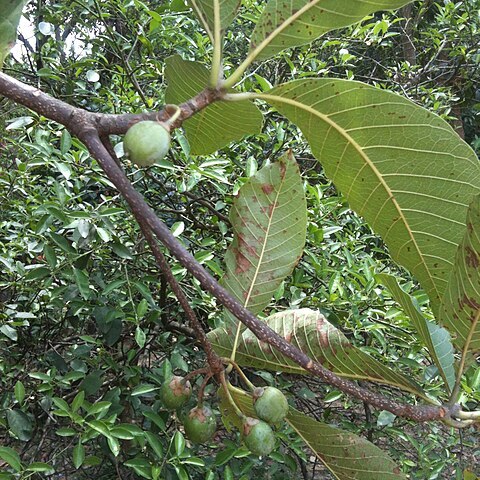Trees to 25 m tall. Branchlets thick, terete to subterete, striate and with lenticels, yellowish brown or brown pubescent to subglabrous. Stipules lanceolate, ca. 5 mm, brown to pale yellow pubescent, early deciduous; leaf blade elliptic-oblong, ovate, or ovate-oblong, (6--)17--35 X (3--)8--17 cm, leathery, yellowish-brown to brown pubescent, base cuneate, apex obtuse to obtuse-acuminate. Flowers axillary, clustered, solitary to 6. Pedicel 2--4.5 cm, to 5 cm in fruit, pubescent. Sepals (4 or)5(or 6), ovate, 0.9--1.5 X 0.6--1 cm, outside pubescent, inside scattered lanate, apex obtuse. Corolla 1.5--2 cm; lobes 8--10, oblong, ovate, or narrowly obovate, (7--)8--10 X (4--)5--8 mm, apex obtuse to acute, margin usually irregularly crenulate. Stamens (18--)20--40, 0.9--1.2 cm, glabrous or brown lanate; anthers sagittate, apex awned. Ovary conical, ca. 2 X 5 mm, rust colored sericeous, 7--12-locular. Style 1.5--5 cm, glabrous. Fruit ovoid-globose to oblong, 2--2.5 X 1--1.5 cm, smooth, apex acute; exocarp fleshy; 1--3(--5)-seeded. Seeds brown, oblong-obovoid, ca. 1.3 X 1 X 0.6 cm, smooth, shiny; scar lanceolate.
More
A deciduous tree. It grows to about 20 m high. The leaves are 14-30 cm long by 7.5-16 cm wide. They are crowded near the ends of branches. They are oval and taper towards the end. They are hairy underneath. The flowers are crowded at the ends of branches. They are yellow. The fruit is a berry. It is pear shaped with one or two seeds. The fruit shape varies.

